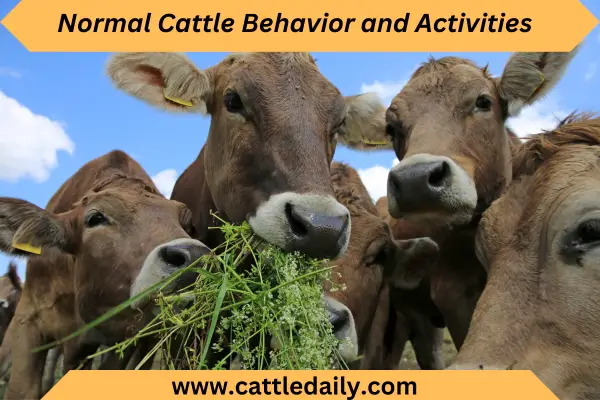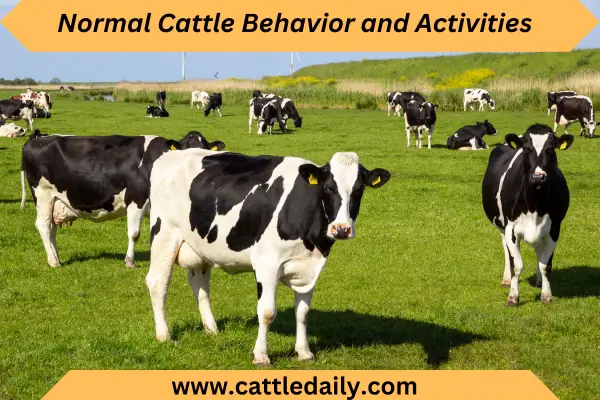Normal Cattle Behavior and Activities
Cattle are herd animals that display distinct patterns of behavior and daily activities. Understanding regular cattle behavior is crucial for cattle owners and ranchers to ensure the health and welfare of their livestock.
In this blog article, we will provide you a comprehensive overview of typical cattle behaviors and routines with its needs and importance to understand cattle behaviours.
What is normal cattle behavior?
Normal cattle behavior refers to the typical actions, interactions, and routines displayed by healthy beef or dairy cattle. Cattle are instinctively social herd animals that thrive when able to perform natural behaviors.
Why is it important to be familiar with normal cattle behavior?
There are several reasons why cattle owners and handlers should understand typical cattle behavior:
- Recognizing normal behavior is key for identifying signs of illness, injury, or distress in cattle. Changes from normal patterns could indicate health issues requiring intervention.
- Understanding natural cattle behaviors allows handlers to move cattle more efficiently in low-stress conditions. For example, knowing that cattle prefer to walk in single file groups reduces frustration for both cattle and handlers.
- Designing proper housing and management routines that allow cattle to perform natural behaviors enhances their welfare and productivity. For instance, ensuring adequate space for social grooming and resting optimizes cattle comfort.
- Being familiar with estrus behavior like standing, riding, and sniffing helps predict ideal times for artificial insemination or bull breeding. This facilitates effective reproductive management.
- Knowing maternal-neonatal bonding behaviors including licking and nursing the newborn ensures the best chance for calf survival and health.
Overall, familiarity with normal cattle behavior provides critical insight for those responsible for managing cattle health and well-being. It enables catching problems early and creating low-stress, welfare-friendly cattle environments.

Daily Life of Cattle
Cattle spend most of their day engaged in four primary activities – grazing, ruminating, resting, and traveling.
1. Grazing
Grazing occupies the majority of a cow’s day, with cattle spending up to 8-9 hours per day feeding on pasture, hay, or silage.
Grazing usually occurs during daylight hours in 2-3 major periods, with peaks in the early morning and late afternoon. While grazing, cattle use their tongues to selectively grab mouthfuls of grasses and other vegetation.
2. Ruminating
Ruminating, or “chewing the cud”, allows cattle to fully digest the cellulose in plants through repeated chewing and swallowing. Adult cattle ruminate for 7-10 hours per day, often while resting.
During rumination, cattle regurgitate boluses of previously swallowed feed back up to their mouths to be re-chewed.
3. Resting
Cattle intersperse periods of feeding with rest, spending up to 12 hours per day resting while lying down. Cows prefer resting on their sternums with their head up, allowing them to easily stand in response to threats. Newborn calves spend more time resting, up to 18 hours a day.
4. Traveling
While grazing, cattle will travel approximately 2.5 miles per day back and forth across a pasture. The herd often walks single file, led by a dominant cow, on well-worn trails to and from their favored grazing areas and water sources.

Herd Dynamics
As herd animals, cattle form complex social structures within a group.
1. Dominance Hierarchy
Each herd has a dominance hierarchy, with one cow as the leader. The dominant cattle have priority access to resources like food, water, and shade. Dominance is established through behaviors like staring, chasing, and bunting (forceful pushing with the head).
2. Social Grooming
Social licking or grooming occurs when one cow licks another, cementing social bonds. Grooming is common among calves and their mothers as well as between pair-bonded cows.
3. Synchronized Activities
Cattle are highly synchronized, coordinating their grazing, resting, traveling, and ruminating. Synchrony enables the herd to remain cohesive and minimizes aggression.
4. Vocal Communication
Cattle use at least 10 distinct vocalizations for communication, including mooing, bellowing, and grunting. For example, cows may bellow to call their calves or grunt while jostling for dominance.

Reproductive Behaviors
Cattle display unique behaviors related to breeding.
1. Estrous Behavior
When a cow enters estrous, she becomes restless and excitable. She may walk fences, bawl, sniff genitals, allow mounting, and ride other cattle.
2. Bull Courtship
Bulls court estrous cows by tending and guarding them. Courtship consists of sniffing, licking, resting the chin on the cow’s back, and mating with the female.
3. Mother-Calf Bonding
Cow-calf bonding begins immediately after birth. The cow intently licks her calf to stimulate breathing and stand up. The pair develops a strong maternal bond critical for the calf’s health and survival.
Other behaviors (flehmen, urine drinking, mounting)
Along with the common grazing, ruminating, resting, and social behaviors, cattle exhibit some additional instinctual behaviors worth noting:
Flehmen response: The flehmen response involves the cow curling back its upper lip and raising its head after sniffing urine or genitals. This transfers scents to the vomeronasal organ to detect pheromones and assess reproductive status.
Urine drinking: Some cows exhibit urine drinking after flehmen by lapping up urine directly. This allows further tasting and evaluation of hormones and pheromones in the urine to gather reproductive information.
Mounting: Dominant cows in estrus may mount other cattle to display social status. Same-sex mounting also occurs as a sign of estrous behavior. Mounting is not always sexual in intent.
Bull riding: Bulls may mount and ride other cattle, both male and female. Again, this establishes rank and serves as a reproductive signal of readiness to breed.
Licking: Tongue licking in cattle can serve multiple purposes. Mother cows lick newborns to care for them. Mutual licking between cows forms social bonds. Licking may also help check for estrous scents.
Variation in cattle behavior
While instincts drive many consistent cattle behaviors, some variation exists among individual animals and cattle groups. Factors like breed, age, sex, health status, and environment can all influence observed behaviors.
Factors that can affect cattle behavior
Breed: Some breed-specific traits can affect behavior – Jersey cows are more vocal while Holsteins are more protective of calves. Brahman cattle exhibit more aggressive behaviors.
Age: Young calves spend more time resting and engage in more social play. Older cattle jostle more for dominance.
Sex: Bulls show sexual mounting more frequently. Estrous behaviors are tied to the reproductive cycle in females.
Health: Sick cattle often isolate themselves from the herd and show signs of weakness, lethargy, or pain.
Housing: Pastured cattle travel farther while confined cattle are more sedentary. Crowding causes competition and aggression.
Handling: Gentle handling minimizes stress. Rough handling makes cattle jittery and reluctant to move.
Weather: Hot weather increases water intake, shade seeking, and rest while cold incites huddling together.
Nutrition: Hungry cattle become competitive at feeding time. Poor nutrition is associated with behavioral signs of illness.
Conclusion
In summary, cattle are highly social grazing animals that divide their day between feeding, ruminating, resting, and traveling. Normal cattle interact through grooming, vocalizations, courtship rituals, and synchronized actions. Understanding typical cattle behavior provides critical insight for proper care and low-stress handling. Learn here more about cattle behavious tips and guidance.


